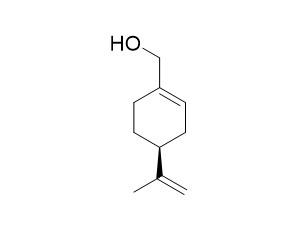(-)-Perillyl alcohol
S-(-)-Perillyl alcohol (PA) shows antinociceptive effects on orofacial nociception in Swiss male mice. PA has been shown to inhibit the isoprenylation of such growth regulatory proteins as ras.
Inquire / Order:
manager@chemfaces.com
Technical Inquiries:
service@chemfaces.com
Tel:
+86-27-84237783
Fax:
+86-27-84254680
Address:
1 Building, No. 83, CheCheng Rd., Wuhan Economic and Technological Development Zone, Wuhan, Hubei 430056, PRC
Providing storage is as stated on the product vial and the vial is kept tightly sealed, the product can be stored for up to
24 months(2-8C).
Wherever possible, you should prepare and use solutions on the same day. However, if you need to make up stock solutions in advance, we recommend that you store the solution as aliquots in tightly sealed vials at -20C. Generally, these will be useable for up to two weeks. Before use, and prior to opening the vial we recommend that you allow your product to equilibrate to room temperature for at least 1 hour.
Need more advice on solubility, usage and handling? Please email to: service@chemfaces.com
The packaging of the product may have turned upside down during transportation, resulting in the natural compounds adhering to the neck or cap of the vial. take the vial out of its packaging and gently shake to let the compounds fall to the bottom of the vial. for liquid products, centrifuge at 200-500 RPM to gather the liquid at the bottom of the vial. try to avoid loss or contamination during handling.
J Ethnopharmacol.2017, 198:87-90
Preprints2022, 2022030063.
Front Pharmacol.2022, 13:883475.
Korean Herb. Med. Inf.2020, 8(2):243-254.
Pathol Res Pract.2024, :260:155445.
Research Square2021, 10.21203.
J Plant Biochem.Biotech.2024, 33:353-366.
Anat Rec2018, 24264
Front Nutr.2023, 10:1181135.
BMC Complement Med Ther. 2020, 20(1):94.
Related and Featured Products
Journal of Nutritional Biochemistry, 1999, 10(1):19-30.
R-(+)-perillyl alcohol-induced cell cycle changes, altered actin cytoskeleton, and decreased ras and p34(cdc2) expression in colonic adenocarcinoma SW480 cells.[Pubmed:
15539246]
Monoterpenes as S-(-)-Perillyl alcohol (PA) have been shown to inhibit the isoprenylation of such growth regulatory proteins as ras.
METHODS AND RESULTS:
In this study, we investigated the effects of the R-(+) enantiomer of PA on cell cycle, signaling, and cytoskeletal control in the colonic adenocarcinoma cell line SW480, which carries a K-ras mutation. Cell cycle analysis by flow cytometry of SW480 cells treated with 1 mM PA for 24 hours demonstrated an increase in the number of cells in G0/G1 with a decrease in S phase, compared with untreated control cells. These cell cycle changes correlated with an inhibition of protein isoprenylation from (14)C-mevalonate and decreased expression of the cell cycle regulatory kinase p34(cdc2). Additionally, PA-treated cells acquired a flattened morphology with a condensation of cytoskeletal actin spikes to the periphery. This was in contrast to treatment with 15 microM mevinolin (MVN), a direct mevalonate synthesis inhibitor, which imparted to SW480 cells a more rounded and spindly morphology, associated with the depolymerization of actin microfilaments. Together, these data suggest that fluctuations in mevalonate and isoprenoid pools may involve different morphologic phenomenon. Because ras mediated signaling is related to the organization of the actin cytoskeleton, we investigated the effects of PA on the isoprenylation of ras. Although MVN treatment inhibited ras farnesylation, PA treatment decreased the expression of total ras protein.
CONCLUSIONS:
In summary, R-(+)-PA-induced cell signaling events correlated with alterations in the organization of cytoskeletal actin and decreased protein expression of growth regulatory proteins, such as ras and cdc2 kinase. These effects may contribute to the growth inhibitory activity of R-(+)-PA.
Int J Oral Maxillofac Surg, 2017, 46(5):662-667.
Orofacial antinociceptive activity of (S)-(-)-perillyl alcohol in mice: a randomized, controlled and triple-blind study.[Pubmed:
28233648]
METHODS AND RESULTS:
This study investigated the antinociceptive effects of (S)-(-)-Perillyl alcohol (PA) on orofacial nociception in Swiss male mice using formalin-, capsaicin-, and glutamate-induced pain tests. For each test, eight animals per group were pre-treated intraperitoneally by a blinded investigator with PA (50 or 75mg/kg), morphine, or vehicle (saline+0.2% Tween 80). The treatment was performed before the induction of orofacial nociception by injecting formalin, capsaicin, or glutamate solution into the right area of the upper lip. The orofacial nociceptive behaviour was timed in all tests by an investigator who was blinded to the treatments. The statistical analysis was performed using confidence intervals (CI), the effect size, and power. PA blocked the orofacial nociceptive behaviour at both doses tested (P<0.05) similarly to morphine (P>0.05), in all tests. The effect size was high in the phase 1 formalin test for 50mg/kg PA (95% CI 0.48-2.31, power 84.6%) and 75mg/kg PA (95% CI 0.82-2.76, power 96.2%), in phase 2 for 75mg/kg PA (95% CI 0.44-2.26, power 82.3%), and in the glutamate test for 75mg/kg PA (95% CI 1.11-3.16, power 99.2%).
CONCLUSIONS:
These findings show strong evidence for the antinociceptive properties of PA in the orofacial region.
Natural Product Communications, 2011, 6(12):1805.
Microbial hydroxylation of S-(-)-perillyl alcohol by Fusarium heterosporium.[Pubmed:
22312710]
METHODS AND RESULTS:
S-(-)-Perillyl alcohol (p-mentha-1, 8-diene-7-ol) (1) (500 mg) was converted by Fusarium heterosporium ATCC 15625 over 10 days at 25 degrees C to a new metabolite, 1,2-dihydroxyperillyl alcohol (p-mentha-8-en-1,2,7-triol) (3) in a yield of 13% (70 mg).
CONCLUSIONS:
The structure of 3 was established by IR and NMR spectroscopic, specific rotation, and mass spectral studies.



